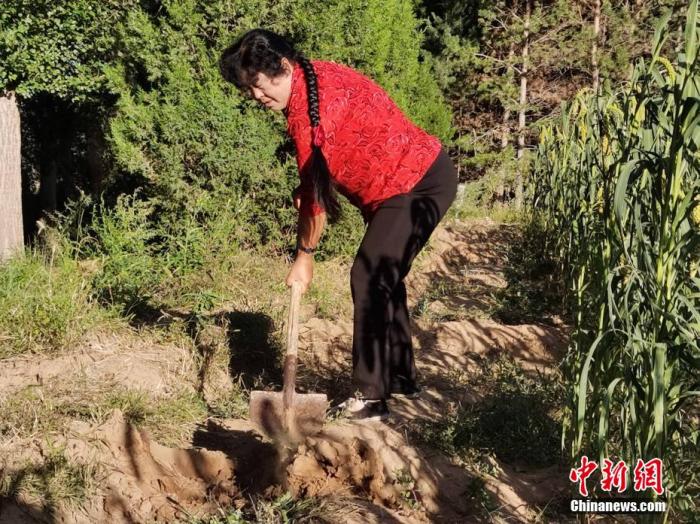China News Service, Ordos, September 29th, title: The "Disappearance" of the Mu Us Desert: The Yellow Sands Changed to Green in China
China News Agency reporter Wu Yana
"A gust of yellow wind makes no distinction between faint and day." "The wind blows yellow sand and it’s hard to open your eyes, and crop seedlings are incomplete. Houses are buried under pressure and people move away and shake their heads when they see the yellow sand." This was once the result of people living in the Mu Us Desert. True portrayal.
The picture shows the trees planted by Yin Yuzhen in the Mu Us Sandy Land.
Photo by Dang Tianye
The Mu Us Desert, which is translated as "bad water" in Mongolian, is one of the four major sandy lands in China, mainly distributed between Ordos City in the Inner Mongolia Autonomous Region and the northern part of Yulin City in Shaanxi Province.
Over the past few decades, from official to non-governmental forces in Mongolia and Shaanxi, various forces have worked hard to combat desertification, gradually turning Mao Usu green on China's territory.
In 1975, the state-owned Ulan Taolgai Sand Control Station in Wushen Banner, Ordos City was established, with a total operating area of 81,000 mu.
Generations of "forest guards" have planted a total of 50,000 mu, with a regional forest coverage rate of more than 60%.
Suyalabayar, the current head of the Sand Control Station, recalled the scene when he first arrived 20 years ago, saying: "There is no road, artificial backs, digging wells on the spot to water, there is no good skin on the shoulders."
"These trees are my children." Yin Yuzhen, the "sand control queen", married into Jingbeitang Village in the hinterland of the Mu Us Desert from Jingbian County, Shaanxi Province in 1985, and lived with her husband in a sand cellar dug out of a sandpit.
Not reconciled to poverty and "companion with sand", Yin Yuzhen decided to start planting trees in the desert.
The picture shows Yin Yuzhen working in the sand.
Photo by Dang Tianye
From ignorance of planting trees in the barren desert to building a "green kingdom" of more than 60,000 mu, Yin Yuzhen has never stopped for more than 30 years.
Canadian traveler Jarry Kobalenko wrote in a picture book written for Yin Yuzhen: "Yin Yuzhen contains every tree and a forest in his heart."
Nowadays, she leads the neighboring villagers to plant trees and control desertification together, combine desertification control with planting industry and aquaculture, and then invest the industry income into sand control, forming a sustainable and virtuous circle ecological industry chain.
One third of the Mu Us Desert is in Yulin City, Shaanxi Province. According to official data, the forest coverage rate in Yulin has increased from 0.9% at the beginning of New China to 33% in 2020, and the control rate of desertified land reached 93.24%.
There is a special Pinus sylvestris forest in Xiaojihan Forest Farm, Yuyang District, Yulin City, which was introduced and planted from Honghuaerji, Hulunbuir, Inner Mongolia in 1964.
A sapling has been widely planted from overcoming "water and soil inconsistency" to being domesticated as the first conifer species for sand control and afforestation in western China. Shi Sheqiang, who is the same age as this forest, is one of the people who experienced it.
The picture shows the trees planted by Yin Yuzhen in the sand.
Photo by Dang Tianye
Shi Sheqiang is an engineer at the Desert Control Research Institute of the Shaanxi Academy of Forestry. He has been dealing with saplings since he started working at the age of 18.
"The breeding and domestication of tree species is a very long process. We have done more than 800 introduction trials, and finally selected more than 40 tree species to promote to production practice." Shi Sheqiang said.
The reporter learned that with the deepening of research, the local area has now mastered the entire set of techniques for seedling raising, afforestation, and breeding of improved varieties. The survival rate of Pinus sylvestris var. mongolica has reached 95%.
This year, the Pinus sylvestris introduced to Yulin from Inner Mongolia that year survived as a naturally renewing tree species. It took 64 years for the transformation from seed to seed.
"We are still constantly researching new tree species and turning our sand control green forests into mixed forests. This is of great significance for preventing pests and diseases and improving economic efficiency." Shi Sheqiang introduced.
Yin Yuzhen planted millions of plants such as willow and pine and cypress in the Mu Us Sandy Land, turning more than 60,000 mu of barren sand into an oasis of life.
Photo by Dang Tianye
"I just chose this line'blindly' without knowing how hard it is to control sand." Zhang Yinglong said with a smile, with the stubbornness and simplicity of the people of northern Shaanxi.
Up to now, the 428,000 mu of sandy land contracted by Zhang Yinglong has accumulated 400,000 mu of artificial forests.
However, Zhang Yinglong's goal is not only that, he hopes to take a circular sand control road through technological innovation.
At present, the Mu Us Sandy Land Ecological Demonstration Park, the Mu Us Ecological Experimental Station of the Xi'an Branch of the Chinese Academy of Sciences, and the National Forestry Director's Almond Engineering Technology Research Center have been established.
Yang Wenbin, a researcher at the Institute of Desertification, Chinese Academy of Forestry, said in an interview with the media, “We hope that the desert will become green and the farmers and herdsmen will become rich. This is our ultimate goal.” (End)

